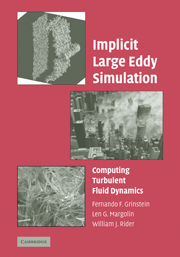Book contents
- Frontmatter
- Contents
- Preface
- List of Acronyms
- List of Contributors
- Introduction
- SECTION A MOTIVATION
- SECTION B CAPTURING PHYSICS WITH NUMERICS
- 3 Subgrid-Scale Modeling: Issues and Approaches
- 4 Numerics for ILES
- 5 Numerical Regularization: The Numerical Analysis of Implicit Subgrid Models
- 6 Approximate Deconvolution
- SECTION C VERIFICATION AND VALIDATION
- SECTION D FRONTIER FLOWS
- Index
- Plate section
3 - Subgrid-Scale Modeling: Issues and Approaches
from SECTION B - CAPTURING PHYSICS WITH NUMERICS
Published online by Cambridge University Press: 08 January 2010
- Frontmatter
- Contents
- Preface
- List of Acronyms
- List of Contributors
- Introduction
- SECTION A MOTIVATION
- SECTION B CAPTURING PHYSICS WITH NUMERICS
- 3 Subgrid-Scale Modeling: Issues and Approaches
- 4 Numerics for ILES
- 5 Numerical Regularization: The Numerical Analysis of Implicit Subgrid Models
- 6 Approximate Deconvolution
- SECTION C VERIFICATION AND VALIDATION
- SECTION D FRONTIER FLOWS
- Index
- Plate section
Summary
Large eddy simulation: From practice to theory
LES: Statement of the problem
It is well known that the direct numerical simulation (DNS) of fully developed turbulent flows is far beyond the range of available supercomputers. Indeed, the computational effort scales like the cube of the Reynolds number for the very simple case of incompressible isotropic turbulence, showing that an increase by a factor of 1,000 in the computational cost will only permit a gain of a factor of about 10 in the Reynolds number. The actual possibilities are illustrated by the results obtained on a grid of 40963 points by Kaneda et al. (2003) simulating incompressible isotropic turbulence at Reλ = 1201 (where Reλ is the Reynolds number based on the Taylor microscale).
The main consequence is that to obtain results at high Reynolds number, all the dynamically active turbulent scales cannot be simulated at the same time: some must be discarded. But, because of the intrinsically nonlinear nature of the Navier–Stokes equations, all turbulent scales are coupled in a dynamic way so that the effects of the discarded scales on the resolved scales must be taken into account to ensure the reliability of the results. This is achieved by augmenting the governing equations for the resolved scales to include new terms that represent the effects of the unresolved scales. The large eddy simulation (LES) technique computes the large scales (where the notion of “large” will be defined) of the flow, while modeling their interactions with small unresolved scales (referred to as subgrid scales) through a subgrid model.
Information
- Type
- Chapter
- Information
- Implicit Large Eddy SimulationComputing Turbulent Fluid Dynamics, pp. 61 - 93Publisher: Cambridge University PressPrint publication year: 2007
Accessibility standard: Unknown
Why this information is here
This section outlines the accessibility features of this content - including support for screen readers, full keyboard navigation and high-contrast display options. This may not be relevant for you.Accessibility Information
- 1
- Cited by
